Writing your first academic paper in Chicago format can be a real nail biter. Not only is the official manual massive, but it can be challenging to know which Chicago style citations to use. Breeze through your essay by breaking down the Chicago and Turabian style format and citations into digestible chunks with a straightforward and comprehensive guide. Get an easy-to-use Chicago style citation generator to fill all your citation needs.
Table of Contents
What Is the Chicago Style?
You might wonder what Chicago’s writing style is since most students’ heads are floating with acronyms like MLA or APA. The University of Chicago Press publishes the Chicago Manual of Style (CMOS), and it’s in its 17th edition. Chicago style is an extensive writing style that is prepared for all different types of papers.
Why Do You Use Chicago Style Citations
Since Chicago style is diverse, you need to understand when you would use Chicago format for your research paper. First, look at your topic. Chicago style is great for writing about subjects like history, arts, literature, and social sciences. It is also a great style to choose if you’re in doubt of which style to use since it is so versatile.

Turabian Format & Citations
When you hear about the Chicago format and writing style as a student, you’ll typically hear of Turabian. Turabian is a form of the Chicago Manual of Style. Named after Kate Turabian, Turabian format is broken down into an easy-to-use format for both high school and college students by providing researching and writing tips. This manual works to provide comprehensive information on how to research your topic and present your findings clearly and accurately using academic standards. So, if you’re a college student writing your first research paper in Chicago style, Turabian is the way to go.
How to Use Turabian Style Citations
In its ninth edition, Turabian provides students with a comprehensive guide for formatting papers, research practices, and preparing submissions. Turabian uses the author-date and notes-bibliography style of CMOS. Therefore, all the information covered about styles and formatting can be used to format a Chicago or Turabian style paper.

Chicago/Turabian Citations: Author-Date vs. Notes-Biblio
You can’t break down the Chicago/Turabian style basics without discussing that it offers you two different ways to cite sources in your paper. You can choose to use the author-date or the notes-biblio style. While this might seem confusing, it isn’t. Much like which writing style you should use, choosing your Chicago citation formatting comes down to your topic.
- Author-date citation works well for topics in sciences, like natural, physical, and social sciences.
- Note-bibliography style citation works for essays on human society, culture, humanities, historical literature, and arts.
Additionally, it should be noted that students at the high school and college-level typically use the author-date style.
Choosing a Thesis Chicago/Turabian Style
Since you have a style in mind, you need to work to create your thesis statement. Your thesis statement is the argument or points you are trying to prove in your paper. It needs to be strong and relevant. It might also change throughout the writing process.
Finding Sources for a Chicago Format Paper
With a thesis at the ready, it’s time to start researching and finding your sources. To make sure your research is robust and credible, you want to look for excellent primary and secondary sources. There are several free primary source websites you can check out. You could also check out public domain sources for useful information.

Creating a Chicago Style Outline
While an outline isn’t necessary, creating an outline in Chicago style is a great way to organize your thoughts and sources in one place. When creating your framework, you want to keep with the Chicago style formatting so that it flows seamlessly into your paper.
Don’t get fooled that an outline is pointless. This step can help you write your paper since all your information is already laid out and organized.
Chicago Outline Example:
I. Introduction
II. First idea
A. Explanation
1. Methodology
2. Literature Review
III. Second idea
A. Overview of Research
1.Study 1
2. Study 2
III. Conclusion
Formatting the Chicago/Turabian Style Paper
The time has come to start formatting your Chicago style paper. And if you chose to create an outline, you’re already a step ahead. Like every writing style, Chicago has rules. Chicago guides you through every step of your essay or research paper creation, from the spacing to the font you use.
Chicago/Turabian Formatting Basics
For Chicago style, you double-space your text, have page numbers near the top, and use 1-inch margins. Your font should be readable and no less than 10 pt. Times New Roman in 12 pt. is typically preferred. Beyond formatting, your paper has different parts.
- Title Page – A title page may or may not be necessary but will include your title, name, class information, and date.
- Main Body – This is where the real meat and potatoes of your research will go.
- References – You’ll cite all the sources you used in either a bibliography or reference list.
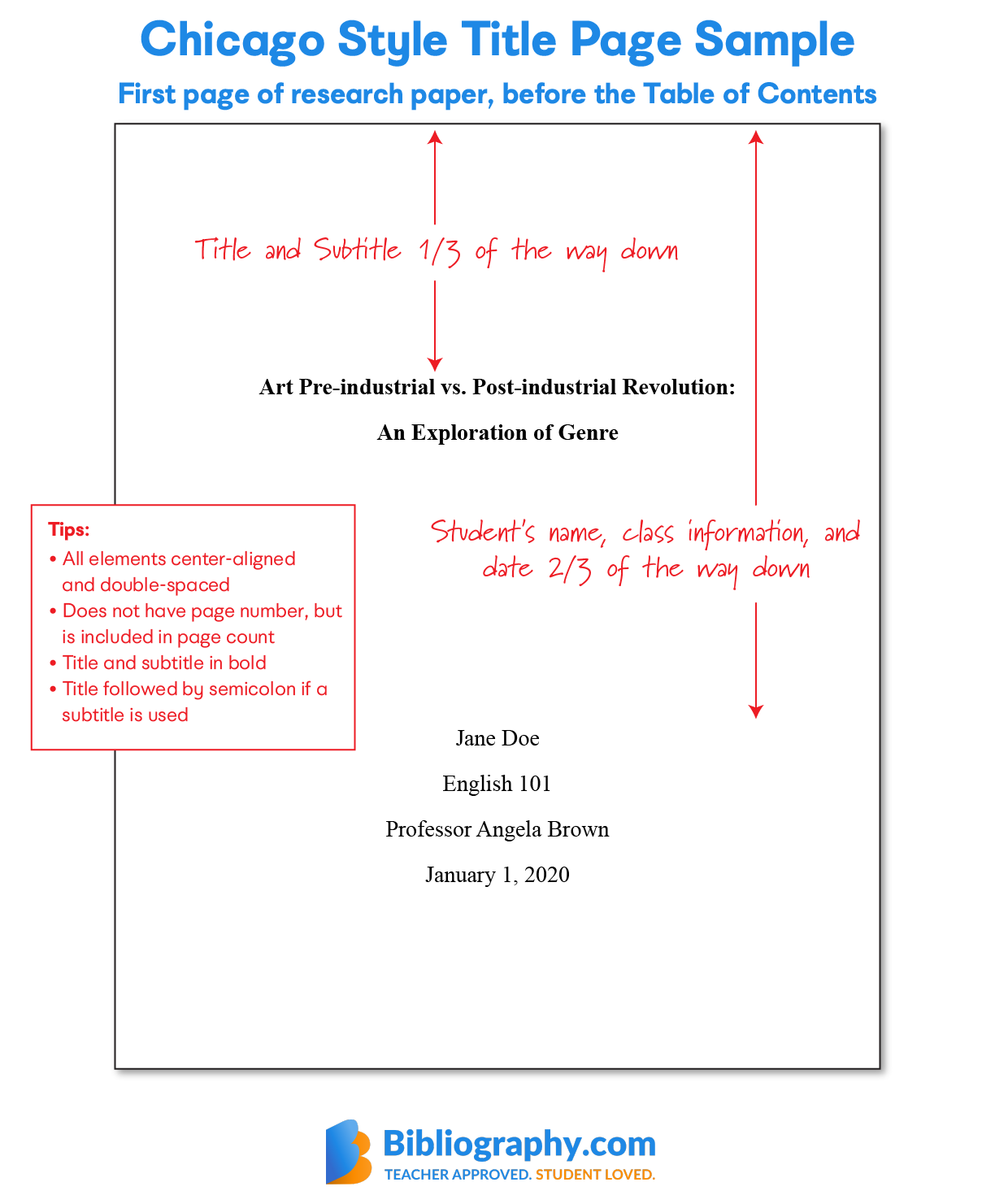
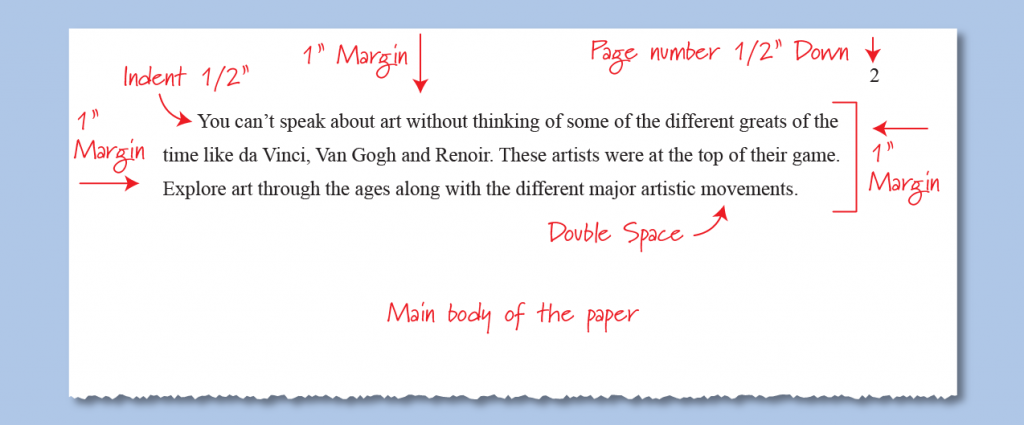
Chicago Format Headings
Chicago doesn’t have a specific guideline when it comes to formatting headings. Therefore, you can use whatever format you feel most comfortable with. However, it’s essential to remain consistent throughout the paper for how you format headings and subheadings. Additionally, use title case when formatting the capitalization of your headings.
Chicago In-Text Citations
Chicago style in-text citations are essential. Why? Because they give credit to those quotes you use within the body of your paper. Trying to pass someone else’s thoughts or words off as your own is plagiarism and will earn you nothing but a big fat F. To avoid plagiarism, you need to make sure that you cite your sources using either author-date and notes-bibliography style citations.
Author-Date Chicago Style Formatting
When it comes to the author-date citations, this is very similar to citations you might make in APA format. Every time that you use a short quote, long quote, blockquote, or paraphrase a section of the text, you’ll indicate the author and date of the work you used. In the text, this will look like: (Orono-Cordova, 96).
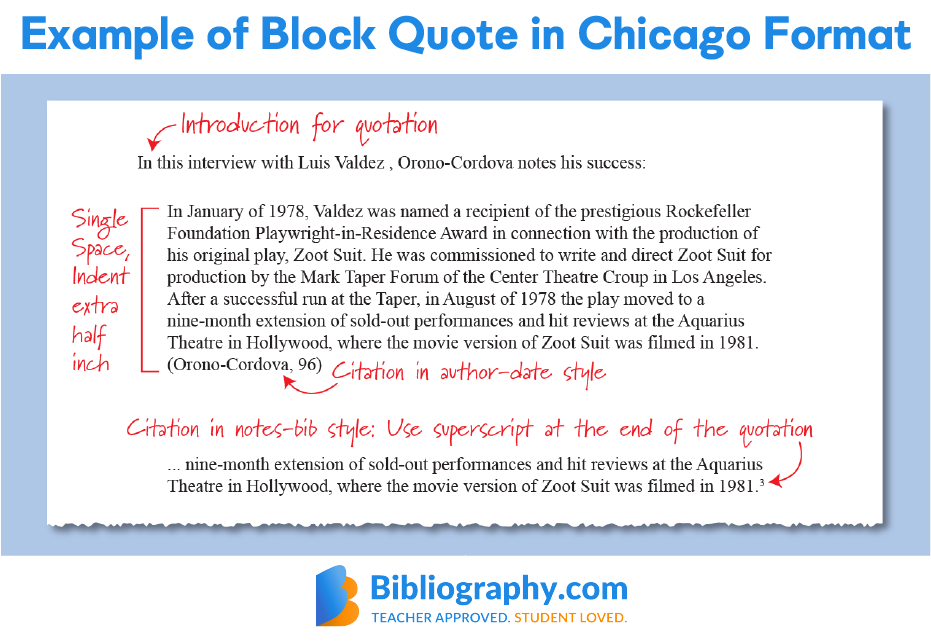
Footnotes and Endnotes Formatting
The other form of in-text citation you’ll be formatting are endnotes and footnotes. While you typically won’t include both endnotes and footnotes in your paper, they are created the same way. In the text, you add a superscript number after the quoted or paraphrased information that corresponds with the endnote or footnote.
You might be wondering what an endnote and footnote are. Well, an endnote is at the “end” of the paper before the bibliography or the end of each chapter for longer essays. A footnote is at the “foot” of the page where you included the quote. Endnotes and footnotes are nice because they don’t clog up your paper with names and dates. Endnotes are cited differently depending on the source but look like:
In-Text Example:
Students feel that culture and diversity are important1 for their college education.
Endnote (Footnote) Example:
1. Peter Parker, “The Increasing of Diversity in College,” Education Today 5, no. 2 (Spring 2020): 12, https://doi.org/xx.xxxxx. Qualitative data show that 10 out of 15 students survey had an expressed need for cultural diversity.
Shortened Endnote (Footnote) Example:
1. Peter Parker, “The Increasing of Diversity in College,” 28-29
1. Peter Parker, 49
As you know, writing for the reader is important. When you are writing a paper with a lot of references to archival material, like in an art history paper, it’s good to provide notes to the reader, so they don’t have to stop reading to look up information.
Chicago Style Citations
It’s time to cite your references. If you used author-date in-text citations, you’re going to create a reference page for the sources you cited in your work. Those that used notes generate a bibliography. A bibliography is unique in that it includes all the sources that you used to create your paper, even if you didn’t cite them directly. In general, your Chicago/Turabian style citation page contains:
- Author
- Publication year
- Publication date
- Publisher
- City of publication
- Date of access
- Page numbers
- URL
How this information is formatted depends on whether you choose author-date or notes-bibliography. So, it is crucial to look at both.
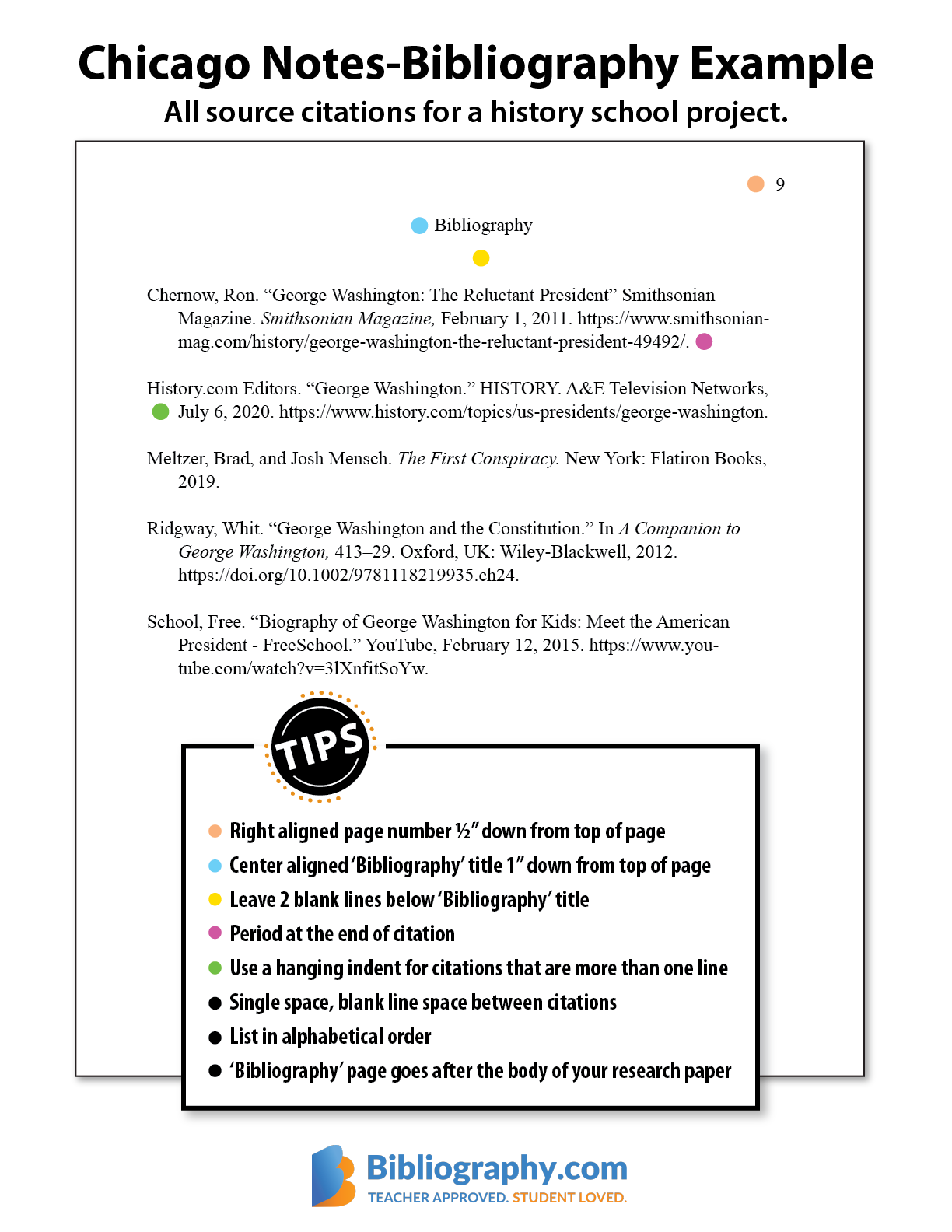
Creating a Reference Page
Creating your references page is all about formatting. In addition to including the title “References” at the top, using hanging indents, and following spacing rules, there are specific sources you can eliminate right off the bat. These include classical works, the Bible, and some arts sources.
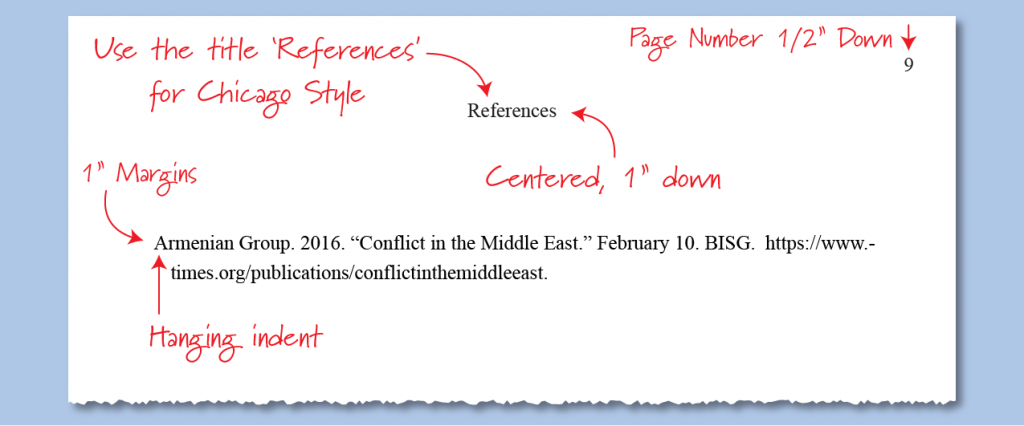
Citing Print Sources in Author-Date Style
Now, it is time to create your print citations. When it comes to author-date reference citations, you will include the creator, identification of the work, date of publication, location of work, and publisher. This is the necessary information to cover for a journal entry, reference work, or book.
Print Example in References:
Thomp, David. 2018. Dictionary of Film. Massachusetts: Knopf.
Media and Digital Sources in Author-Date
Visual and performing arts, audio, video, and online sources require extra information in Chicago’s author-date style. Instead of publication information, you may include the URL/DOI, site owner, and/or medium.
Website Example in References:
Revolution Industry Group. 2016. “Steps to Publishing.” March 7. BISG. https://www.rig.org/publications/bisq-quick-start-guide-accessible-publishing.
TV Example in References:
This Is Us. 2019. Season 4, Episode 3, “Unhinged.” Directed by Dan Fogelman. Aired October 8, 2019 on ABC.
Periodical Sources in Author-Date
Periodical citations in author-date style can get a little tricky. That is because there are so many different periodicals out there, like monthly, weekly, and yearly journals; magazine articles; county and national newspapers; and multiple other articles that are available with a wealth of exciting research. For a periodical citation, include the author, article title, journal/magazine title, volume number, issue, and date.
Journal Example in References:
Bailey, Anthony. 2014. “Autism Treatment Research.” Autism Research 7 (1): 1–3. https://doi.org/10.1002/aur.1358.
Formatting Your Bibliography in Chicago Style
Since you’re using the notes-biblio Chicago/Turabian full bibliography style, you center the title Bibliography on the last page. Do not bold, underline, or italicize the title.
- Center “Bibliography” as the title.
- Double-space after the title, then begin your entries.
- Use the hanging indent for each entry.
- Space one line between entries.
Alphabetize by the letter-by-letter method by author and then by title unless your instructor asks you to use the word-by-word method. Ignore A, An, or The if it’s the first word in a title.
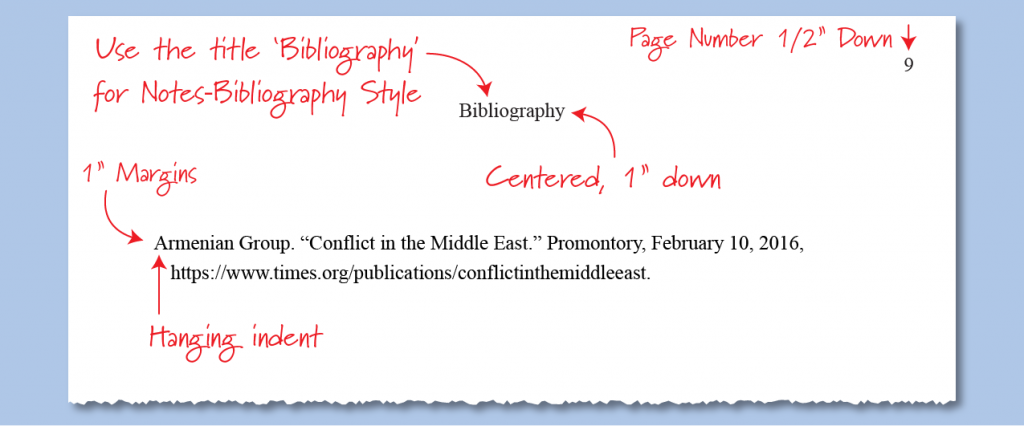
Citing Print Sources in Your Bibliography
When it comes to print sources, you’ll be making citations for books, reference works, and art catalogs. These sources will have a publisher, possibly a volume, and page numbers. You will want to include all of that information, plus the author and title, in your citation.
Print Example in Bibliography:
Barber, Katherine, ed. Canadian Oxford Dictionary. 2nd ed. Oxford: Oxford University Press, 2004. https://doi.org/10.1093/acref/9780195418163.001.0001.
Citing Digital and Media Sources in a Chicago Style Bibliography
Another standard citation you’ll come across, especially in your arts papers, will be for digital and media sources. Online source bibliography citations have a URL or DOI listed. Multimedia bibliography citations include the location of the source and name of the producer, while visual arts bibliography citations consist of the location of the work.
Website Example for Bibliography:
Kavena, Ken. “Interview with Darrel Quin.” Promontory, February 19, 2020, www.kued.org/productions/promontory/interviews/quin.html.
TV Example for Bibliography:
This Is Us. Season 4, Episode 3, “Unhinged.” Directed by Dan Fogelman. Aired October 8, 2019 on ABC.
Periodicals for Notes-Bibliography
Just like with author-date, periodical citations can get a bit confusing. For journals, magazines, etc., you’ll include the author, title, journal title, volume, issue, and date.
Periodical Example:
Darrell, Kevin. “Past and Present Chinese Lexicon.” Dictionaries: Journal of the Dictionary Society of North America 4 (2010): 210-222.
Omitted Sources in Chicago Bibliography
Now, let’s talk about sources you can omit from your bibliography in the notes-biblio style. Pretty much any source that isn’t authoritative or is hard to link to can be left off the bibliography like:
- Newspaper articles
- Abstracts
- Pamphlets
- Reviews of published works or performances
- Blog posts/comments
- Classical, medieval, early English works
- The Bible
- Artwork, plays, and live performances
- The US Constitution
- Social media posts
- Interviews
- Personal communications, like emails
- Statutes
- Legal cases
These are included in the notes only. However, if you feel the cited source is critical to your argument or if you use it frequently in your paper, you may include it in your notes-biblio style bibliography.
Sectioning Your Bibliography
Sectioning your notes-biblio style bibliography is a design choice you make to guide your reader. Your reader needs to understand why and how you chose to section the bibliography. Write a headnote underneath your bibliography title explaining your thought process and how it helps the reader.
For example, if you chose to section your bibliography by author, write a short headnote explaining that each author’s contribution to a certain aspect of the subject led you to this format. If you have sources from many places, you may choose to section your bibliography by location or type of sources, such as archival materials, websites, and print materials.
Creating an Author Section
As you know, you must provide your reader with a clear, easy to understand way to follow your research path. Creating sections by authors, who are authorities in their fields, helps your reader gain an understanding of the experts in the subject. If your reader is using your research to further their own research, this format guides them to these experts.
Bibliographies and reference lists are sorted alphabetically. This creates some difficulty when you have sources that do not fit well into an alphabetized list. In this case, you may create your bibliography sections by sources. What does this mean?
Subdividing Bibliographies by Source
Simply put, you will divide your bibliography into sections that make it easiest for your reader to find your sources. Here are some examples:
- Archival Manuscripts
- Artistic Works
- General Reference Works
- Online Sources
You may also create subdivisions within your sections. For example, General Reference Works may be subdivided into categories such as dictionaries and encyclopedias or by subject such as ecology and geography.
Other Ways to Subdivide Bibliographies
You may consider creating sections by subject. For example, if you write about literary characters, create a section about each character. Or, if you write a paper about a particular author, such as Charles Dickens, you may create separate sections for books he wrote and books written about him.
One of the most common methods of sectioning is by works you’ve consulted and works you’ve actually used within your paper. This method makes it easier for the reader to follow notes directly to the bibliography.
Annotated Bibliography in Chicago Style
Another way to make your bibliography stand out is to make it a Chicago style annotated bibliography. This is where you annotate your bibliography to provide either a summative or evaluative overview of each work listed. This can give your readers a little more insight into the different works you used to write your paper.

Chicago Citation Maker
Whether you are creating a reference or bibliography page for your anthology essay, looking at examples can make things a lot clearer. And, if you took the easy way out and used a citation generator, then you can double-check that your generator was on top of its game. Not only does this make your life a ton easier, but this citation creator is checked for accuracy.
Mastering Chicago Style Citations
Mastering any writing style is rough. Chicago can be even tougher because there are at least a couple of different ways you can go, including author-date and notes-biblio. Thankfully, Turabian is available for students to help guide them through the process. Now that you know everything about Chicago, you might want to check out MLA format or APA citations.
FAQ Chicago Style Citations and Format
How do you cite in Chicago style?
The way you cite in-text and on the reference page of your Chicago style paper depends on whether you are using author-date or notes-biblio style. These are the two different citation styles offered by Chicago style. However, the author-date is the more popular of the two.
What is Chicago style citation used for?
Chicago citation is used for all different types of research papers. The author-date style citation works better for science research papers. However, the notes-biblio style works great for humanities and art papers.
What is Chicago Manual style?
The Chicago manual of style is a writing guide created by the Chicago Press. It is currently in its 17th edition and offers diverse citation formats for users.
Where do page numbers go in Chicago Style Citation?
The page number in a Chicago style citation paper goes in the upper right-hand corner. It is formatted as a running header that keeps the page count throughout your entire work.
Who uses Chicago Manual of Style?
The Chicago Manual of Style is used by students and professional academic writers. It is one of the three popular writing styles that also includes MLA and APA.

